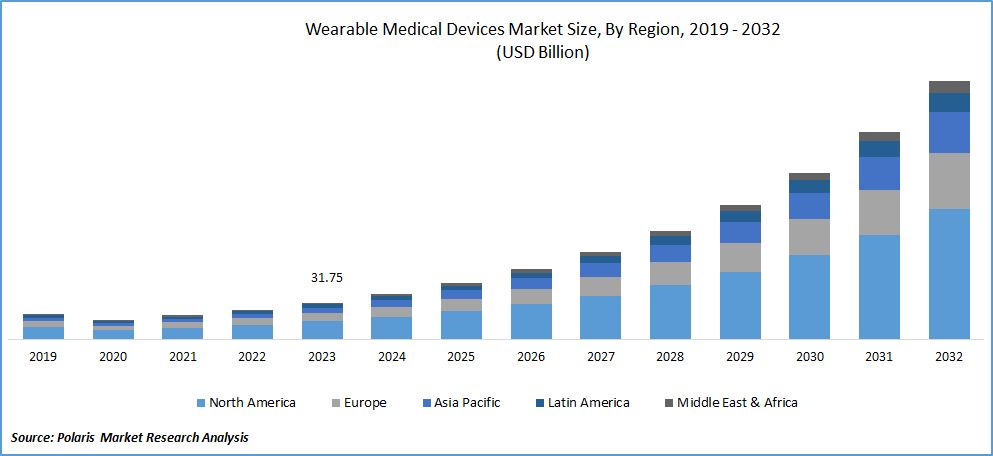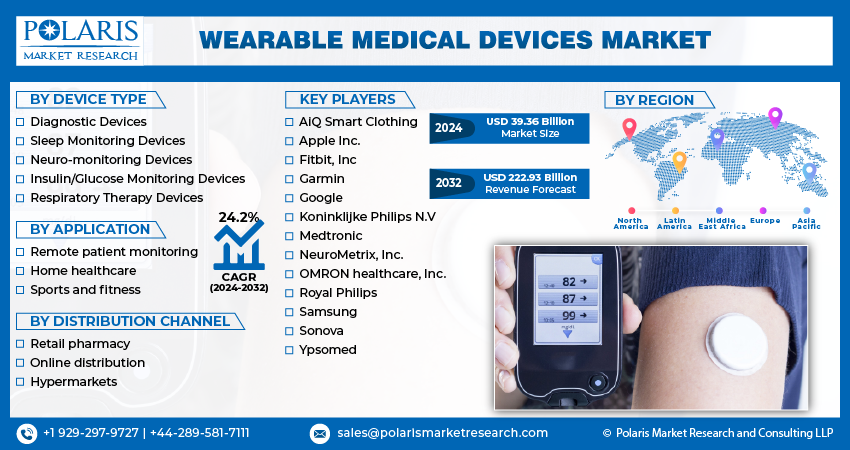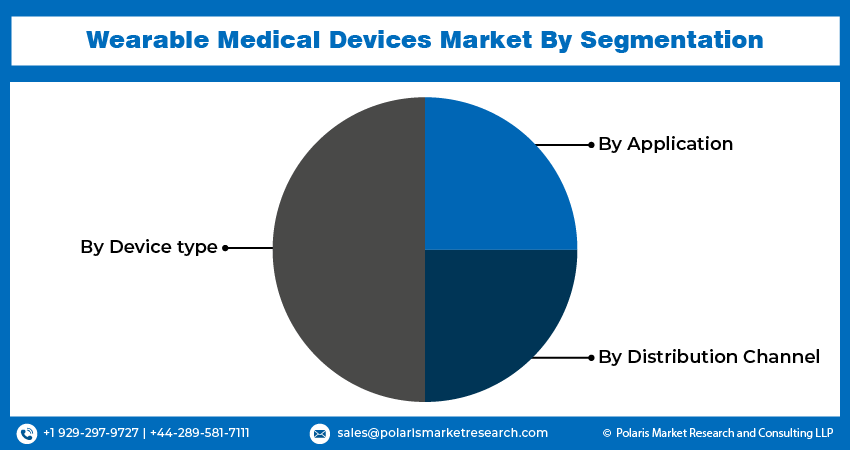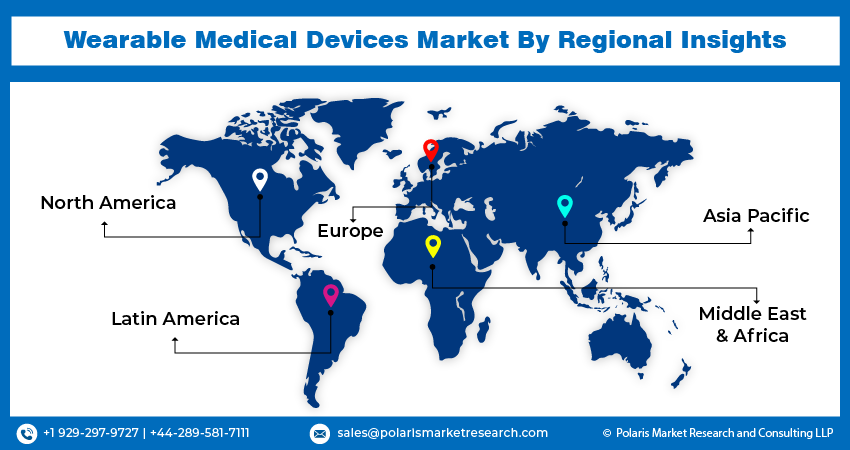
Wearable Medical Device Market Share, Size, Trends, Industry Analysis Report, By Device Type (Diagnostic Device And Therapeutic Device); By Application; By Distribution channel; By Region; Segment Forecast, 2024- 2032
- Published Date:Feb-2024
- Pages: 117
- Format: PDF
- Report ID: PM1686
- Base Year: 2023
- Historical Data: 2019-2022
Report Outlook
Wearable medical device market size was valued at USD 31.75 billion in 2023. The market is anticipated to grow from USD 39.36 billion in 2024 to USD 222.93 billion by 2032, exhibiting the CAGR of 24.2% during the forecast period.
Industry Overview
The global Wearable Medical Device Market was valued at USD 31.75 billion in 2023 and is expected to grow at a CAGR of 24.2% during the forecast period.
Compact electronic devices known as wearable medical devices are intended to be worn on the body as clothes or accessories in order to monitor and gather different health-related data. These gadgets have sensors to monitor sleep patterns, physical activity, vital indicators, and other relevant data. They provide consumers with vital current health status details and are essential for wellness tracking, illness management, and personal health monitoring.
Patients with chronic illnesses depend on wearable medical devices because they allow for real-time vitals monitoring and prompt action in the event of abnormalities. Physicians can remotely monitor their patient’s real-time health activity. As a result, fewer needless hospital visits occur, increasing their effectiveness and productivity in providing community healthcare. Patients' healthcare costs are decreased, and proactive health management is promoted.

To Understand More About this Research: Request a Free Sample Report
Increase in number of chronic diseases such as heart disorder, diabetes and others have predicted to positively drive the market. As moreover, athletes and fitness passion look for innovative ways to track their health, it is also projected that the worldwide fitness and health industry will expand quickly. A noteworthy segment of the populace in the United States and Canada comprises a substantial number of early adopters. Since the market is estimated to grow in the upcoming years.
Wearable medical devices have become a trend in the healthcare industry as wearable technology has gained popularity in recent years. From monitoring vital signs to tracking one's actions and locations, wearable devices seem to be used to collect or transmit biometric data. Wearables are usually worn on wrists or waists, so they're wearable and invisible.
The demand for people to improve their health and the recent technology developments in wearables have spurred a number of industry participants to produce additional smart gadgets, including Fit-bits, biosensors, and hearing aids. In addition, one of the main drivers expected to drive wearable medical device sales during the forecast period is the rising prevalence of chronic diseases and disorders associated to lifestyle choices.
During the initial pandemic outbreak and periods of high local COVID-19 case count, various states, towns, and nations implemented shelter-in-place orders and restrictions to minimize the potential exposure and transmission of the virus. Consequently, no-income and other variable expenses for medical treatments and medication these industry experienced a significant decline in 2020. However, there was sharp rise in the market post covid-19 due to increasing health consciousness in major population. Companies are actively engaged in product development, partnerships, and strategic collaborations to enhance technology in wearable medical device further. These factors are expected to drive market growth in the forecast period.

Key Takeaways
- North America dominated the largest market and contributed to more than 37% of share in 2023
- Asia Pacific region, projected to experience the fastest growth throughout the forecast period.
- By device type category, diagnostic device segment accounted for the largest market share in 2023
- By application category, Sports and fitness segment accounted for the highest revenue share in 2023
What are the market drivers driving the demand for Wearable Medical Device Market?
Increasing Prevalence of Chronic Diseases across the Globe is projected to spur the product demand.
Increasing Prevalence of Chronic Diseases across the Globe
The use of wrist wearable devices in healthcare is being significantly impacted by the growing consumer need to take charge of their health. The advancement of wearable technology is a major factor in the healthcare industry's use of wrist wearables, including fitness trackers, smartwatches, medical monitors, and other similar devices. The need for sophisticated wearable devices is being driven by the introduction of new wearable medical devices with cutting-edge capabilities that monitor health-related issues and facilitate the diagnostic process for medical professionals. The wrist wearable devices market is also being driven by the launch of wearable pulse oximeters and blood glucose monitors, which are both gaining significant momentum in the healthcare industry.
The rising prevalence of long-term illnesses The incidence and prevalence of chronic diseases have increased as a result of a sedentary lifestyle combined with unhealthful dietary practices. Additionally, many survivors of the COVID-19 pandemic now have lengthy COVID, which highlights the need for ongoing patient monitoring. For example, during the COVID-19 epidemic, there was a spike in demand for pulse oximeters for use in home healthcare. The population's adoption of an active lifestyle has increased due to growing health consciousness, which has increased demand for smartwatches that measure vital signs to monitor fitness and health progress. The importance of mental wellness and the increased emphasis on health to provide access to healthcare and medication will both fuel the worldwide wearable medical device market
Which factor is restraining the demand for Wearable Medical Device?
Data Privacy and Security Concerns likely to impede the market growth.
Data privacy and security concerns impede the market growth in the wearable medical device industry. Several factors contribute to these concerns, and addressing them is essential for building trust among users and ensuring sustained market growth.
Wearable medical devices often collect and transmit sensitive health information, including vital signs, activity levels, and, in some cases, even more detailed health metrics. The potential exposure of such sensitive data raises privacy concerns among users. The risk of data breaches and cyberattacks is a significant concern. If wearable medical device data falls into the wrong hands, it can lead to identity theft, unauthorized access to medical histories, or even manipulation of health data, posing serious risks to individuals' privacy and safety.
Report Segmentation
The market is primarily segmented based on device type, application, distribution channel, and region.
|
By Device type |
By Application |
By Distribution Channel |
By Region |
|
|
|
|
To Understand the Scope of this Report: Speak to Analyst
Category Wise Insights
By Device Type Insights
Based on Device type analysis, the market is segmented on the basis of diagnostic device and therapeutic device. In 2023, the diagnostic device segment accounted for the largest revenue share. The increasing desire among consumers to take control of their health is having a substantial impact on the use of wrist-wearable devices in healthcare. The usage of wrist wearables in the healthcare sector, such as fitness trackers, smartwatches, medical monitors, and other comparable gadgets, is greatly influenced by the development of wearable technology. The advent of new wearable medical gadgets with cutting-edge capabilities that monitor health-related issues and speed up the diagnostic process for medical experts is driving the need for smart wearables. The introduction of wearable blood glucose monitors and pulse oximeters, which are both gaining a lot of traction in the healthcare sector, is another factor propelling the opportunity and demand of wearable medical device Market.
For example, Tan Tock Seng Hospital (TTSH) and Nanyang Technological University, Singapore (NTU Singapore) have developed an assistive robot that can prevent and detect falls. The MRBA (Mobile Robotic Balance Assistant), with its associated safety belt worn around the user's hips, senses a loss of balance immediately and uses its sensors to catch the user.
By Application Insights
Based on application analysis, the market has been segmented on the basis of remote patient monitoring, home healthcare and sports and fitness. The sports and fitness segment accounted for the highest revenue share in 2023, due to rising athletes and fitness fanatics. The market will expand as a result of younger people consuming these goods at higher rates. The market will expand nicely as more people become aware of the advantages of using these gadgets. Because more people have more purchasing power, even in developing countries, the market for wearable technology and devices is anticipated to expand significantly throughout the forecast period. The advancement of wearable technology is a major factor in the healthcare industry's use of wrist wearables, including fitness trackers, smartwatches, medical monitors, and other similar devices. Rising opportunities in sports and changing lifestyles have been increasing the demand for the use of wearable devices, anticipating the wearable medical device industry share to boom over the forecast period.

Regional Insights
North America
In 2023, North America accounted for the largest market share due to the increasing in the prevalence of chronic disease, which imposes a major economic concern, and possesses affordable treatment in the United States. New players with new and advanced technology, the high acceptance rate of sophisticated goods, and significant compensation have contributed to the significant wearable medical device market in the North American region.
Based on a 2019 survey conducted by the Pew Research Center, it was found that 21% of U.S. adults regularly use a fitness band or wearable fitness tracker. Notably, women exhibit a higher regular usage rate compared to men, with 25% of women and 18% of men incorporating these devices into their routines. Interestingly, 41% of respondents express acceptance of fitness tracker manufacturers sharing user information with medical professionals to enhance understanding of the relationship between exercise and heart disease. This survey underscores the widespread popularity and adoption of wearable devices in the United States. Considering these factors, the growth of the wearable medical devices market in the U.S. is anticipated to be positively influenced during the forecast period.
Asia Pacific
In the Asia Pacific region, the wearable medical device market is projected to experience the fastest growth throughout the forecast period. Government initiatives in the Asia Pacific region are favorably supporting the adoption of wearable medical instruments. These initiatives may include policies, subsidies, or regulations that encourage the use of such devices in healthcare, contributing to market growth opportunity. The region is experiencing a rise in the geriatric population, which often requires continuous health monitoring. Wearable medical devices offer solutions for remote patient monitoring and healthcare management, addressing the healthcare needs of the growing elderly demographic. Japan is characterized by rapid technological advancements, particularly in the healthcare sector. This includes the development of advanced wearable medical devices that cater to the needs of remote patient monitoring, ensuring timely and effective healthcare interventions.

Competitive Landscape
The wearable medical device market is characterized by intense competition, with established players relying on advanced technology, high-quality products, and a strong brand image to drive revenue growth. These companies employ various strategies such as research and development, mergers and acquisitions, and technological innovations to expand their product portfolios and maintain a competitive edge in the market.
Some of the major players operating in the global market include:
- AiQ Smart Clothing
- Apple Inc.
- Fitbit, Inc
- Garmin
- Koninklijke Philips N.V
- Medtronic
- NeuroMetrix, Inc.
- OMRON healthcare, Inc.
- Royal Philips
- Samsung
- Sonova
- Ypsomed
Recent Developments
- In July 2023, German company Henkel changed a molding technology that is frequently employed in industrial electronics to create a broader range of medical wearables. The single-step over-mould design takes the place of conventional clamshell housings. Glucose monitors, smart patches, and even smart eyeglasses are examples of medical wearables that are becoming more and more popular as healthcare facilities try to reduce the costs of in-house monitoring and offer additional comfortable patient monitoring at home or on the go.
- August 2020, Fitbit Inc. declared the release of Fitbit Sense, a device that tracks heart rate and has a skin temperature sensor.
Report Coverage
The Wearable Medical Device market report emphasizes on key regions across the globe to provide better understanding of the product to the users. Also, the report provides market insights into recent developments, trends and analyzes the technologies that are gaining traction around the globe. Furthermore, the report covers in-depth qualitative analysis pertaining to various paradigm shifts associated with the transformation of these solutions.
The report provides detailed analysis of the market while focusing on various key aspects such as competitive analysis, device types, applications, distribution channel, and their futuristic growth opportunities.
Wearable medical device Market Report Scope
|
Report Attributes |
Details |
|
Market size value in 2024 |
USD 39.36 billion |
|
Revenue forecast in 2032 |
USD 222.93 billion |
|
CAGR |
24.2% from 2024 – 2032 |
|
Base year |
2023 |
|
Historical data |
2019 – 2022 |
|
Forecast period |
2024– 2032 |
|
Quantitative units |
Revenue in USD million/billion and CAGR from 2024 to 2032 |
|
Segments Covered |
By Device Type, By Application, By Distribution Channel, By Region |
|
Regional scope |
North America, Europe, Asia Pacific, Latin America; Middle East & Africa |
|
Customization |
Report customization as per your requirements with respect to countries, region and segmentation. |
FAQ's
Wearable Medical Devices Market report covering key segments are device type, application, distribution channel, and region.
Wearable Medical Device Market Size Worth $ 222.93 Billion By 2032
Wearable medical device market exhibiting the CAGR of 24.2% during the forecast period.
North America is leading the global market.
The key driving factors in Wearable Medical Devices Market are Increasing Prevalence of Chronic Diseases across the Globe
